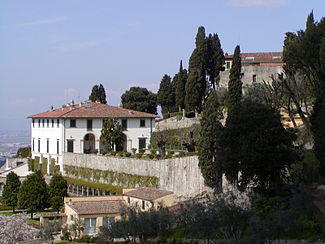This article needs additional citations for verification. (May 2009) (Learn how and when to remove this template message) |

A villa was originally an ancient Roman upper-class country house. Since its origins in the Roman villa, the idea and function of a villa have evolved considerably. After the fall of the Roman Republic, villas became small farming compounds, which were increasingly fortified in Late Antiquity, sometimes transferred to the Church for reuse as a monastery. Then they gradually re-evolved through the Middle Ages into elegant upper-class country homes. In modern parlance, 'villa' can refer to various types and sizes of residences, ranging from the suburban "semi-detached" double villa to residences in the wildland–urban interface.
Contents
Roman
- the villa urbana, a country seat that could easily be reached from Rome or another city for a night or two
- the villa rustica, the farm-house estate that was permanently occupied by the servants who had charge generally of the estate, which would centre on the villa itself, perhaps only seasonally occupied. The Roman villae rusticae at the heart of latifundia were the earliest versions of what later and elsewhere became called plantations.
Not included as villae were the domus, a city house for the élite and privileged classes; and insulae, blocks of apartment buildings for the rest of the population. In Satyricon (1st century CE), Petronius described the wide range of Roman dwellings. Another type of villae is the "villa marittima", a seaside villa, located on the coast.
A concentration of Imperial villas existed on the Gulf of Naples, on the Isle of Capri, at Monte Circeo and at Antium (Anzio). Examples include the Villa of the Papyri in Herculaneum; and the "Villa of the Mysteries" and "Villa of the Vettii" in Pompeii.
Wealthy Romans also escaped the summer heat in the hills round Rome, especially around Tibur (Tivoand Frascati, such as at Hadrian's Villa. Cicero allegedly possessed no fewer than seven villas, the oldest of which was near Arpinum, which he inherited. Pliny the Younger had three or four, of which the example near Laurentium is the best known from his descriptions.
Roman writers refer with satisfaction to the self-sufficiency of their latifundium villas, where they drank their own wine and pressed their own oil. This was an affectation of urban aristocrats playing at being old-fashioned virtuous Roman farmers, it has been said that the economic independence of later rural villas was a symptom of the increasing economic fragmentation of the Roman Empire.
In Roman Britannia
Archaeologists have meticulously examined numerous Roman villas in England. Like their Italian counterparts, they were complete working agrarian societies of fields and vineyards, perhaps even tileworks or quarries, ranged round a high-status power centre with its baths and gardens. The grand villa at Woodchester preserved its mosaic floors when the Anglo-Saxon parish church was built (not by chance) upon its site. Grave-diggers preparing for burials in the churchyard as late as the 18th century had to punch through the intact mosaic floors. The even more palatial villa rustica at Fishbourne near Winchester was built (uncharacteristically) as a large open rectangle, with porticos enclosing gardens entered through a portico. Towards the end of the 3rd century, Roman towns in Britain ceased to expand: like patricians near the centre of the empire, Roman Britons withdrew from the cities to their villas, which entered on a palatial building phase, a "golden age" of villa life. Villae rusticae are essential in the Empire's economy.
Two kinds of villa-plan in Roman Britain may be characteristic of Roman villas in general. The more usual plan extended wings of rooms all opening onto a linking portico, which might be extended at right angles, even to enclose a courtyard. The other kind featured an aisled central hall like a basilica, suggesting the villa owner's magisterial role. The villa buildings were often independent structures linked by their enclosed courtyards. Timber-framed construction, carefully fitted with mortises and tenons and dowelled together, set on stone footings, were the rule, replaced by stone buildings for the important ceremonial rooms. Traces of window glass have been found, as well as ironwork window grilles.
Monastery villas of Late Antiquity
With the decline and collapse of the Western Roman Empire in the fourth and fifth centuries, the villas were more and more isolated and came to be protected by walls. In England the villas were abandoned, looted, and burned by Anglo-Saxon invaders in the fifth century. But the concept of an isolated, self-sufficient agrarian working community, housed close together, survived into Anglo-Saxon culture as the vill, with its inhabitants - if formally bound to the land - as villeins.
In regions on the Continent, aristocrats and territorial magnates donated large working villas and overgrown abandoned ones to individual monks; these might become the nuclei of monasteries. In this way, the Italian villa system of late Antiquity survived into the early Medieval period in the form of monasteries that withstood the disruptions of the Gothic War (535–554) and the Lombards. About 529 Benedict of Nursia established his influential monastery of Monte Cassino in the ruins of a villa at Subiaco that had belonged to Nero.
From the sixth to the eighth century, Gallo-Roman villas in the Merovingian royal fisc were repeatedly donated as sites for monasteries under royal patronage in Gaul - Saint-Maur-des-Fossés and Fleury Abbey provide examples. In Germany a famous example is Echternach; as late as 698, Willibrord established an abbey at a Roman villa of Echternach near Trier, presented to him by Irmina, daughter of Dagobert II, king of the Franks. Kintzheim was Villa Regis, the "villa of the king". Around 590, Saint Eligius was born in a highly placed Gallo-Roman family at the 'villa' of Chaptelat near Limoges, in Aquitaine (now France). The abbey at Stavelot was founded ca 650 on the domain of a former villa near Liège and the abbey of Vézelay had a similar founding.
Post-Roman era
In post-Roman times a villa referred to a self-sufficient, usually fortified Italian or Gallo-Roman farmstead. It was economically as self-sufficient as a village and its inhabitants, who might be legally tied to it as serfs were villeins. The Merovingian Franks inherited the concept, followed by the Carolingian French but the later French term was basti or bastide.
Villa/Vila (or its cognates) is part of many Spanish and Portuguese placenames, like Vila Real and Villadiego: a villa/vila is a town with a charter (fuero or foral) of lesser importance than a ciudad/cidade ("city"). When it is associated with a personal name, villa was probably used in the original sense of a country estate rather than a chartered town. Later evolution has made the Hispanic distinction between villas and ciudades a purely honorific one. Madrid is the Villa y Corte, the villa considered to be separate from the formerly mobile royal court, but the much smaller Ciudad Real was declared ciudad by the Spanish crown.
Italian Renaissance
Tuscany
In 14th and 15th century Italy, a villa once more connoted a country house, like the first Medici villas, the Villa del Trebbio and that at Cafaggiolo, both strong fortified houses built in the 14th century in the Mugello region near Florence. In 1450 Giovanni de' Medici commenced on a hillside the Villa Medici in Fiesole, Tuscany, probably the first villa created under the instructions of Leon Battista Alberti, who theorized the features of the new idea of villa in his De Re Aedificatoria.
These first examples of Renaissance villa predate the age of Lorenzo de' Medici, who added the Villa di Poggio a Caiano by Giuliano da Sangallo, begun in 1470, in Poggio a Caiano, Province of Prato, Tuscany.
From Tuscany the idea of villa was spread again through Renaissance Italy and Europe.
Tuscan villa gardens
The Quattrocento villa gardens were treated as a fundamental and aesthetic link between a residential building and the outdoors, with views over a humanized agricultural landscape, at that time the only desirable aspect of nature. Later villas and gardens include the Palazzo Pitti and Boboli Gardens, Florence; the Villa di Pratolino, Province of Siena.
Rome
Rome had more than its share of villas with easy reach of the small sixteenth-century city: the progenitor, the first villa suburbana built since Antiquity, was the Belvedere or palazzetto, designed by Antonio Pollaiuolo and built on the slope above the Vatican Palace.
The Villa Madama, the design of which, attributed to Raphael and carried out by Giulio Romano in 1520, was one of the most influential private houses ever built; elements derived from Villa Madama appeared in villas through the 19th century. Villa Albani was built near the Porta Salaria. Other are the Villa Borghese; the Villa Doria Pamphili (1650); the Villa Giulia of Pope Julius III (1550), designed by Vignola. The Roman villas Villa Ludovisi and Villa Montalto, were destroyed during the late nineteenth century in the wake of the real estate bubble that took place in Rome after the seat of government of a united Italy was established at Rome.
The cool hills of Frascati gained the Villa Aldobrandini (1592); the Villa Falconieri and the Villa Mondragone. The Villa d'Este near Tivoli is famous for the water play in its terraced gardens. The Villa Medici was on the edge of Rome, on the Pincian Hill, when it was built in 1540. Besides these designed for seasonal pleasure, usually located within easy distance of a city, other Italian villas were remade from a rocca or castello, as the family seat of power, such as Villa Caprarola for the Farnese.
Near Siena in Tuscany, the Villa Cetinale was built by Cardinal Flavio Chigi. He employed Carlo Fontana, pupil of Gian Lorenzo Bernini to transform the villa and dramatic gardens in a Roman Baroque style by 1680. The Villa Lante garden is one of the most sublime creations of the Italian villa in the landscape, completed in the 17th century.
Venice
In the later 16th century in the northeastern Italian Peninsula the Palladian villas of the Veneto, designed by Andrea Palladio (1508–1580), were built in Vicenza in the Republic of Venice. Palladio always designed his villas with reference to their setting. He often unified all the farm buildings into the architecture of his extended villas. Examples are the Villa Emo, the Villa Godi, the Villa Forni Cerato, the Villa Capra "La Rotonda", and Villa Foscari.
The Villas are grouped into an association (Associazione Ville Venete) and offer touristic itineraries and accommodation possibilities.
Villas abroad
17th century
Soon after in Greenwich England, following his 1613–1615 Grand Tour, Inigo Jones designed and built the Queen's House between 1615–1617 in an early Palladian architecture style adaptation in another country. The Palladian villa style renewed its influence in different countries and eras and remained influential for over four hundred years, with the Neo-Palladian a part of the late 17th century and on Renaissance Revival architecture period.
Watch movie Villa online on Amazon
Watch movie Villa online
Watch The Movie On PrimeSant Gyaneshwar Full HD Movie Download

Welcome to Sajjanpur Full HD Movie Download

Aitbaar (1985) Full HD Movie Download
.jpg)
Arjun Full HD Movie Download

Saaheb Full HD Movie Download

Sampoorna Ramayana Full HD Movie Download

Meharbaan (1967) Full HD Movie Download
.jpg)
Maachis Full HD Movie Download

Ghazab Full HD Movie Download

Jaan Hatheli Pe Full HD Movie Download

Teri Talash Mein (1990) Full HD Movie Download
.jpg)
Game (Hindi) Full HD Movie Download
.jpg)
Ayyaa Full HD Movie Download

Ganga Kinnare Pyaar Pukkare Full HD Movie Download

Jay Maa Full HD Movie Download

Saptapadi Full HD Movie Download

Return Of Khuda Gawah Full HD Movie Download

Troy Full HD Movie Download

Lakshami Narasima Full HD Movie Download

Kokila Full HD Movie Download

Padavi Pramanam Full HD Movie Download

Download latest Movie from bollywood
- 1> baaghi 3
- 2> THE SKY IS PINK MOVIE FULL STORY AND REVIEW
- 3> Luka Chuppi
- 4> TO ALL THE BOYS I’VE LOVED BEFORE
- 5> Kabir Singh
- 6> Street Dancer 3D
- 7> Simmba
- 8> Gone Girl
- 9> The Girl Who Lived
- 10> Ludo
- 11> DILWALE DULHANIA LE JAYENGE
- 12> GUILTY
- 13> The Godfather
- 14> Adventures of Rusty
- 15> Sooryavanshi
- 16> Satyameva Jayate 2
- 17> Thappad
- 18> Bhool Bhulaiyaa 2
- 19> KGFChapter 2
- 20> Mardaani 2
- 21> Pinjar
- 22> Shivaji maharaj
- 23> Ek Villian 2
- 24> Hungama 2
- 25> Divergent
- 26> Mumbai Saga
- 27> The Internship
- 28> HIT (telugu)
- 29> Panga
- 30> The perfect date
- 31> 16 December
- 32> Gopala Gopala (Telugu)
- 33> Brahmastra
- 34> Gangubai Kathiawadi
- 35> Manmadhudu
- 36> Nenu local
- 37> Mahanati
- 38> Shatamanam bavathi
- 39> Lagaan
- 40> After
- 41> MOM
- 42> Shamshera
- 43> Raguvaran BTech
- 44> Khakee
- 45> The villain
- 46> OM
- 47> Mr. perfect
- 48> Bueatifull mind
- 49> Hichki
- 50> Gabbar Singh
- 51> Jogi
- 52> Before Sunrise
- 53> Before Sunset
- 54> Before Midnight
- 55> The Big Bull
- 56> Top Gun: Maverick
- 57> The Purge
- 58> The Sky is Pink
- 59> Laxmmi Bomb
- 60> Sadak 2
- 61> Sufna
- 62> Prithviraj
- 63> PK
- 64> Coolie No 1(2020)
- 65> Black Widow
- 66> Dear Zindagi
- 67> Dil Bechara
- 68> PHIR HERA PHERI
- 69> WAR
- 70> Dostana
- 71> RRR: Roudram Ranam Rudhiram
- 72> Maidan
- 73> Dabbang 3
- 74> Chhalaang
- 75> life as we know it
- 76> SherShaah
- 77> Sandeep Aur Pinky Faraar
- 78> Event Horizon
- 79> 83
- 80> Radhe: Your Most Wanted Bhai
- 81> Gunjan Saxena: The Kargil Girl
- 82> Mr India
- 83> Vivah
- 84> Anokha Bandhan
- 85> Ghost
- 86> Bhoot: Part One - The Haunted Ship
- 87> Haseen Dilruba
- 88> Laal Singh Chaddha
- 89> Qismat
- 90> Rajput
- 91> Drive
- 92> Dil Chahta Hai
- 93> Dil Ki Baazi
- 94> Dil Ka Rishta
- 95> Teesri Manzil
- 96> Dil
- 97> Love Aaj Kal
- 98> Khaali Peeli
- 99> Bunty Aur Babli 2
- 100> Atrangi Re
- 101> Gulabo Sitabo
- 102> Jodi
- 103> Suraj Pe Mangal Bhari
- 104> Deewana
- 105> Attack
- 106> Sardar Udham Singh
- 107> Toofan
- 108> THE LOVEBIRDS
- 109> Jersey
- 110> Ginny Weds Sunny
- 111> Thalaivi
- 112> Shiddat
- 113> Angels vs Zombies
- 114> Koi Mil Gya
- 115> Thank God
- 116> Bhuj: The Pride of India
- 117> Hum Aapke Hain Kaun
- 118> The Platform
- 119> Bird Box
- 120> Roohi Afzana
- 121> Torbaaz
- 122> Nikamma
- 123> World War Z
- 124> Extraction
- 125> Train to Busan
- 126> Life of Pi
- 127> SHAADI MEIN JROOR AANA
- 128> Himmat Aur Mehnat
- 129> To All The Boys: P.S. I Still Love You
- 130> Mimi
- 131> Good Newwz
- 132> Shubh Mangal Zyada Saavdhan
- 133> Raabta
- 134> Harry Potter and the Philosopher's Stone
- 135> Harry Potter and the Chamber of Secrets
- 136> Chhapaak
- 137> War of the Worlds
- 138> Harry Potter and the Prisoner of Azkaban
- 139> Harry Potter and the Goblet of Fire
- 140> MURDER MYSTERY
- 141> Shakuntala Devi
- 142> Bachchan Pandey
- 143> Jayeshbhai Jordar
- 144> Sheer Qorma
- 145> Saina
- 146> 'O' Pushpa I hate tears
- 147> Kedarnath
- 148> MS Dhoni The Untold Story
- 149> Chhichhore
- 150> Badhaai Ho
- 151> Unstoppable
- 152> Oz the Great And Powerful
- 153> The Girl on the Train
- 154> Haathi Mere Saathi 2020
- 155> The Conjuring: The Devil Made Me Do It
- 156> Gandhi Se Pehle Gandhi
- 157> The Song of Scorpions
- 158> Srimanthudu
- 159> Hello Guru Prema Kosame
- 160> Beauty and The Beast
- 161> Black Panther
- 162> Charlie and the Chocolate Factory
- 163> Bole Chudiyan
- 164> Fidaa
- 165> Duvvada Jagannadham
- 166> Bruce Lee: The Fighter
- 167> Hyper
- 168> Yaara
- 169> Red (2020)
- 170> Shivam
- 171> That Is Mahalakshmi
- 172> Nishabdham
- 173> Aashram 2020 web series
- 174> Laxmii
- 175> Mismatched
- 176> STUDENT OF THE YEAR 2
- 177> NAIL POLISH
- 178> Ramprasad Ki Tehrvi
- 179> KAAGAZ
- 180> 12 o Clock
- 181> The Power
- 182> bolo hau
- 183> Tribhanga
- 184> JAMUN
- 185> Madam Chief Minister
- 186> Maasaab
- 187> Aadhaar
- 188> Tanhaji
- 189> Bhaagi 3
- 190> Bhootnath
- 191> MALANG
- 192> Jai Mummy Di
- 193> Haathi Mere Saathi 2021
- 194> Shakeela
- 195> Unpaused
- 196> Annayya
- 197> Vamsoddharakudu
- 198> Mrugaraju
- 199> Narasimha Naidu
- 200> Sankranti
- 201> Manasu Maata Vinadhu
- 202> Anjaane
- 203> Apaharan
- 204> Bachke Rehna Re Baba
- 205> Bewafaa
- 206> Roohi
- 207> Radhe
- 208> Zindagi Khoobsoorat Hai
- 209> Yeh Mohabbat Hai
- 210> Yeh Kya Ho Raha Hai?
- 211> The Tomorrow War
- 212> DehradunDiary
- 213> Meri Shaadi Karaoo
- 214> Matruu Ki Bijlee Ka Mandola
- 215> No One Killed Jesica
- 216> Aag Ka Goola
- 217> Eight Million Dollars
- 218> Three Hundred
- 219> Cats and Dog
- 220> Decoy
- 221> Gold Rush
- 222> You Have Got Mail
- 223> Final Destination three
- 224> Tofan
- 225> Jungle
Request for Download movie Villa
- Bollywood movies
- Latest Bollywood movies
- Download all bengali movies
- Download all bhojpuri movies
- Download all english movies
- Download all gujarati movies
- Download all hindi movies
- Download all kannada movies
- Download all malayalam movies
- Download all marathi movies
- Download all oriya movies
- Download all punjabi movies
- Download all tamil movies
- Download all telugu movies
- Bollywood action movies
- Bollywood adventure movies
- Bollywood animation movies
- Bollywood classical movies
- Bollywood comedy movies
- Bollywood crime movies
- Bollywood devotional movies
- Bollywood documentary movies
- Bollywood drama movies
- Bollywood family movies
- Bollywood fantasy movies
- Bollywood historical movies
- Bollywood history movies
- Bollywood horror movies
- Bollywood musical movies
- Bollywood mystery movies
- Bollywood mythological movies
- Bollywood patriotic movies
- Bollywood romance movies
- Bollywood romantic movies
- Bollywood sci-fi movies
- Bollywood social movies
- Bollywood spiritual movies
- Bollywood sports movies
- Bollywood suspense movies
- Bollywood thriller movies
- Bollywood war movies
- Hot actress list
- Hot gujarati actress list
- Hot tamil actress list
- Hot bhojpuri actress list
- Hot assam actress list
- Hot bihari actress list
- Hot jammu and kashmir actress list
- Hot gujarati actress list
- Hot haryana actress list
- Hot konkani actress list
- Hot marathi actress list
- Hot odia actress list
- Hot punjabi actress list
- Hot rajasthani actress list
- Hot kannada actress list
- Hot malayalam actress list
- Hot telugu actress list
- Hot tulu actress list
- Hot Actress list from Indian city
- Hot actress list from ahmedabad
- Hot actress list from alappuzha
- Hot actress list from bangalore
- Hot actress list from bangalore
- Hot actress list from bhopal
- Hot actress list from chandigarh
- Hot actress list from chennai
- Hot actress list from guwahati
- Hot actress list from hyderabad, india
- Hot actress list from indore
- Hot actress list from jaipur
- Hot actress list from kannur
- Hot actress list from kochi
- Hot actress list from kolkata
- Hot actress list from kollam
- Hot actress list from kottayam
- Hot actress list from kozhikode
- Hot actress list from lucknow
- Hot actress list from madurai
- Hot actress list from mangalore
- Hot actress list from mumbai
- Hot actress list from mysore
- Hot actress list from new delhi
- Hot actress list from patna
- Hot actress list from pune
- Hot actress list from thiruvananthapuram
- Hot actress list from thrissur
- Hot actress list from tiruchirappalli
- Hot actress list from vijayawada
- Hot actress list from visakhapatnam
- All Bollywood Movies
- Bollywood Celeb
- >Art Director
- >Audiography
- >Background Music
- >Banner
- >Choreographer
- >Cinematographer
- >Costume Designer
- >Dialogue Writer
- >Director
- >Distributor
- >Editor
- >Executive Producer
- >Hair Stylist
- >Lyricist
- >Music Director
- >Photographer
- >Playback Singers
- >Presenter
- >Producer
- >Production Company
- >Production Designer
- >Screenplay
- >Singer
- >Sound
- >Actor
- >Story Writer
- >Studio
- >Video Director
- >Miscellaneous
- >Publicity (pro)
- >Web Creator
- >Production Labs
- >Publicity Design
- >Publicity Stills
- >Writer
- >Miscellaneous Artists
- >Visual Effects
- >Reporter
- >Music Company
- >Shooting Studios
- >Picturised On
- >Line Producer
- >Co Producer
- >Asst Director
- >Casting Director
- >Cinematography
- >Choreography
- >Dialouge
- >Editing
- >Lyrics
- >Music
- >Story
- >Playback Singer Female
- >Playback Singer Male
- >Actor In A Comic Role (male/female)
- >Child Artiste
- >Ensemble Cast
- >Actor Popular Choice (male)
- >Actor Popular Choice (female)
- >Sa Re Ga Ma Pa Song Of The Year
- >Actor In Supporting Role
- >Actress In Supporting Role
- >Actor In Leading Role
- >Art Direction
- >Actress In Leading Role
- >Sound Recording
- >Costume Design
- >Special Effects
- >Action
- >Actor In A Negative Role
- >Lifetime Achievement Award
- >Cinematic Exellence (director)
- >Cinematic Exellence (male)
- >Cinematic Exellence (female)
- >International Male Icon
- >International Female Icon
- >Actor In A Supporting Role (male)
- >Actor In A Supporting Role (female)
- >Actor In A Comic Role
- >Playback Singer (male)
- >Playback Singer (female)
- >Most Promising Debut (female)
- >Most Promising Debut (male)
- >Most Promising Director
- >Sound Design
- >Lifetime Jodi
- >Marketed Film
- >Jury Award For Best Actor
- >Jury Award For Best Actress
- >Jury Award For Best Film
- >Jury Award For Best Director
- >Playback Singer(male)
- >Lifetime Acheivement Award (male)
- >Excellence Award
- >Jodi Award
- >Performer Of The Year
- >Presented By
